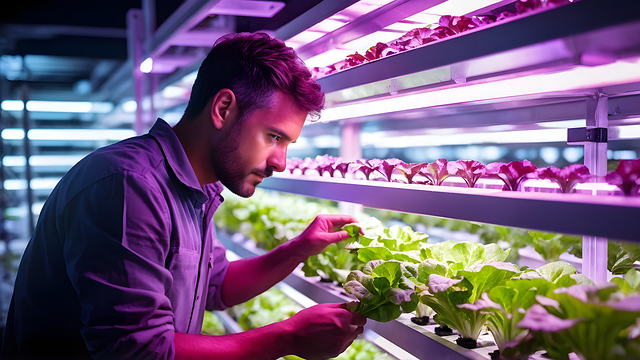
Smart Farming has always been a challenging but rewarding industry, especially as modern agriculture demands higher yields and improved efficiency. For farmers trying to balance productivity with profitability, cost-efficiency becomes a crucial focus. Whether you’re a large-scale commercial farmer or a small-scale grower, cutting costs without sacrificing the quality of your yield is possible through smart farming strategies. This blog will explore several ways to reduce agricultural expenses while maintaining high productivity.
1. Optimize Resource Use
One of the most effective ways to reduce farming costs is to manage resources wisely. Water, fertilizer, and energy can all be significant expenses, but with the right techniques, you can use these resources more efficiently.
- Water Management: Irrigation can be one of the highest expenses in farming. Switching to drip irrigation or precision irrigation systems allows you to deliver water directly to plant roots, minimizing waste and maximizing efficiency. Additionally, rainwater harvesting can further cut down on water costs by storing and using rainwater for irrigation.
- Fertilizer Application: Overusing fertilizers not only leads to unnecessary expenses but can also harm the environment. Consider precision agriculture tools that use data analytics to assess soil needs and apply fertilizers only where they are needed. This method minimizes waste and ensures plants receive just the right amount of nutrients. Composting is also a cost-effective alternative to chemical fertilizers, turning organic waste into valuable nutrients for your soil.
2. Embrace Technology
Technology is revolutionizing the agricultural sector, and smart investments in technology can drastically reduce long-term costs while improving yield.
- Drones and Sensors: By investing in drones and soil sensors, you can monitor your fields more effectively. These technologies allow for real-time insights into soil health, moisture levels, and crop growth, enabling you to make informed decisions that reduce resource waste.
- GPS and Precision Farming: GPS technology enables precision farming, which optimizes planting, watering, and fertilizing activities. This method increases the efficiency of farming operations and reduces the overuse of resources. While there may be an upfront cost to adopting these technologies, the long-term savings and increased productivity typically outweigh the initial investment.
3. Leverage Government Programs and Grants
Many governments offer subsidies, grants, or low-interest loans for farmers adopting sustainable or innovative practices. These programs can help offset some of the initial costs of upgrading equipment, adopting new technologies, or transitioning to more eco-friendly farming methods. Take time to research available programs in your area and apply for assistance that can help you farm smarter on a budget.
Additionally, many countries offer tax incentives for energy-efficient equipment or sustainable practices. For instance, investing in solar panels or wind turbines for your farm could qualify you for tax breaks, ultimately reducing your energy bills.
4. Diversify Your Crops
Monoculture farming, while efficient in the short term, can be risky and expensive in the long run due to its reliance on a single crop. Diversifying your crops spreads the risk of crop failure and can improve soil health, reducing the need for chemical fertilizers.
- Crop Rotation: Practicing crop rotation helps prevent soil depletion and reduces the likelihood of pest infestations, which means fewer pesticides and lower input costs. Different crops also have different nutrient requirements, so alternating crops can naturally replenish soil nutrients, reducing the need for fertilizers.
- Diversify Income Sources: Consider adding alternative income streams such as selling value-added products like jams, pickles, or organic fertilizers. Hosting agritourism activities, such as farm tours or workshops, can also provide additional revenue with minimal investment.
5. Adopt Sustainable Farming Practices
Sustainability and cost-efficiency often go hand-in-hand. Sustainable farming practices not only protect the environment but also reduce reliance on costly external inputs.
- Conservation Tillage: This practice minimizes soil disruption, reducing the need for heavy machinery and fuel. Conservation tillage also helps retain moisture in the soil and improves its organic matter, cutting down on water and fertilizer needs.
- Integrated Pest Management (IPM): IPM uses a combination of biological, cultural, and mechanical methods to control pests, reducing the need for expensive chemical pesticides. This approach not only cuts costs but also minimizes the environmental impact of farming.
6. Collaborate with Other Farmers
Farming can be a lonely business, but collaboration can lead to significant savings. Consider forming or joining a farm cooperative to share resources like machinery, storage facilities, or transportation. Equipment sharing reduces the need for every farmer to own expensive machinery, cutting down on individual capital expenditures.
Additionally, bulk purchasing of seeds, fertilizers, and other supplies can lower costs for cooperative members, while shared marketing efforts can open up new sales channels or improve bargaining power with buyers.
7. Use Low-Cost or Alternative Energy Sources
Energy costs can escalate rapidly, particularly if your farm depends on machinery or refrigeration. By switching to renewable energy sources like solar, wind, or biogas, you can achieve significant long-term savings. Not only do these alternatives help reduce your carbon footprint, but they also lower electricity bills—especially when paired with energy-efficient equipment and practices.
In Utah, local solar companies offer tailored solutions for agricultural operations, helping farmers take advantage of the state’s abundant sunshine to further cut energy expenses and boost sustainability.
8. Repair and Maintain Equipment
A well-maintained tractor or harvester will last far longer than one that is neglected. Regular maintenance can prevent costly breakdowns and prolong the lifespan of your machinery, reducing the need for expensive replacements. Learn basic repair skills and conduct routine inspections to ensure your equipment remains in good working order.
In Conclusion
Farming on a budget doesn’t mean sacrificing productivity or quality. By optimizing resource use, embracing technology, and adopting sustainable practices, you can cut costs while maintaining or even improving your farm’s output. Collaborating with other farmers and leveraging government programs can also provide valuable financial support. With smart strategies in place, you can achieve both economic and environmental sustainability in your farming operations.




